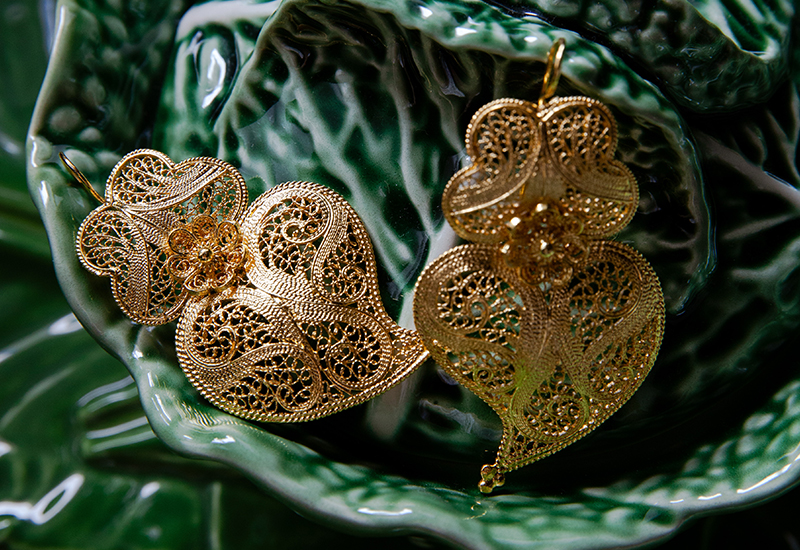Imagine delicate golden threads, as fine as a strand of hair, ably intertwined by the hands of a master craftsman. Welcome to the ancient art of filigree, a perfect Valentine’s gift.
You may be unaware that Portugal has a longstanding tradition in the art of goldsmithing. In the past, the north of Portugal had abundant gold and skilled talent to work it. It was in the hills of Pias and Banja that the Roman people discovered gold mines, and thus, thanks to trade routes, filigree began to emerge. Filigree jewellery produced in national territory appears during the Muslim rule of the peninsula, around the 8th century AD.
The exact origin of this technique is unknown, but various samples have been found all over the world. In Portugal, examples of this technique have been found dating back to around 2,000 BC, with Phoenician origins. In the workshops, where Portuguese filigree is still intricately crafted, there’s pride, or as the residents from Minho say, a “Chieira”, in doing everything by hand and with a lot of patience. Machines may try to compete in filigree production, but this art maintains a strong connection to manual skill.
Queen D. Maria I ordered the creation of the first filigree heart at the end of the 18th century to thank God for the birth of a male child. This symbol carries a profound religious connotation, representing the Sacred Heart of Jesus, where, at the top, we can glimpse the burning flames of the earth and the warmth of love. The 25 steps to create a Viana Heart (Coração de Viana) are slow and meticulous, producing only one piece per day.
Threads intertwined with pride, initially resembling golden hair, are skillfully woven to shape the symbol of the city of Viana do Castelo.
The queen’s earrings are another example of Portuguese craftsmanship. The origin of the name probably goes back to the reign of D. Maria II (1819–1853). The queen wore a pair of earrings on a visit to Viana do Castelo in 1852. After this visit, they became popular as a symbol of wealth and status.
During the Pilgrimage of Agonia in the north of Portugal, the “Mordomas” and “Brides of Viana do Castelo” parade their pieces of golden filigree, traditionally attempting to catch the eyes of young men. On display are impressive Viana heart-shaped pendants, or small ones resembling “relicários” (queen’s earrings), or the traditional spindle earrings, long beaded necklaces, and shorter ones – anything goes to showcase the richness of Portuguese filigree!
Today, this art takes on various forms, from delicate pieces adorned with religious motifs to creations with a polished and contemporary design. Over time, filigree transcends its festive origins, evolving into an artistic expression that blends tradition and modernity.
The tradition of wearing this symbol on the chest had its origin in Viana do Castelo, but today, filigree manufacturing in Portugal is mainly concentrated in the areas of Gondomar and Póvoa do Lanhoso. The mountains of Pias and Banjas, which provide the raw material, have made the region one of the most notable nuclei of Portuguese jewellery. In 2018, Gondomar was responsible for 60% of the national jewellery production.
Filigree has gained a new lease of life in the hands of jewellery designers, who reimagine its essence and free it from religious concepts. The brand Portugal Jewels has also embarked on a contemporary approach, not forgetting the roots of tradition but fusing traditional and modern concepts in harmony.
Brands like Portugal Jewels have recognised the potential of Portuguese tradition and have been helped to showcase this corner of Europe to other countries. Thus, filigree, once tied to religious symbolism, now flourishes as a modern artistic expression, revealing the beauty and skill of Portuguese filigree masters to the world. The history of filigree continues to unfold, oscillating between tradition and innovation, like a narrative that transcends borders and captivates admirers worldwide.
In the month dedicated to love, the tradition continues to shine as it did in the days of yore. Giving a piece of filigree is not just gifting a jewel; it’s sharing love and preserving a part of Portugal’s history. Discover meaningful Valentine’s Day gifts at Mar d’Estórias!
Did you know: Portuguese gold is 19.2 carats (pure gold is 24).
Rua Silva Lopes, Nº 30, 8600-623 Lagos
Photo © Sanda Vučković













